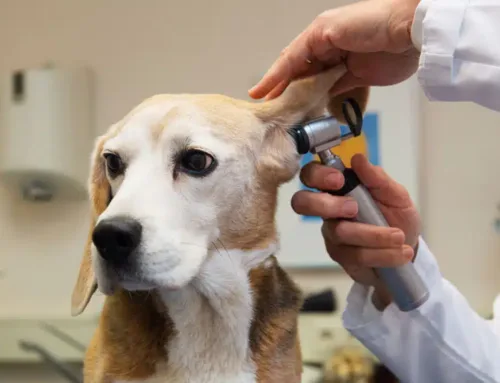Skin conditions in pets can arise at any time but are more prevalent in the warmer spring and summer months. If your pet frequently scratches, licks, or rubs their skin, you also feel their discomfort. These conditions often stem from underlying issues, so identifying and addressing them promptly is vital to prevent escalation and potential treatment complications.
However, pet skin conditions can be hard to identify. Your Fairfax Veterinary Clinic team put together this resource-packed guide about recognizing skin conditions and what we can do to help your pet feel more comfortable.
Flea allergy dermatitis in pets
Although fleas are easily preventable, flea allergy dermatitis (FAD) is one of the most common skin conditions veterinarians treat. Fleas irritate every pet, but pets with FAD can have an intense reaction from a single flea bite that can result in constant scratching, oozing sores, hair loss, especially over the hind end, red and inflamed skin, and secondary bacterial infections. Pets with FAD must be on a strict flea preventive and bathing schedule, and pet owners must eliminate all fleas in the home by washing pet bedding frequently and cleaning the house thoroughly. A professional extermination service may be necessary to eliminate all the fleas and flea eggs.
Atopic dermatitis in pets
A pet’s allergy that manifests as a skin problem and is triggered by something in the environment, such as pollen, grasses, mold, or dust, is referred to as atopic dermatitis. Pets with atopy are incredibly uncomfortable and may scratch or bite their feet, faces, and skin repetitively. They also commonly suffer red, raw feet, recurrent ear infections, and skin lesions. Treatment includes bathing your pet with hypoallergenic shampoos, wiping their feet and paws after being outdoors, using air purifiers with high-efficiency particulate air (HEPA) filters in your home, and oral medications, such as apoquel or cytopoint.
Bacterial infections in pets
When other skin conditions go untreated, secondary bacterial skin infections can occur. Broken skin from intense itching and scratching can leave skin exposed to bacteria, resulting in infections with open, oozing sores, redness, swelling, extreme discomfort, and foul odor. At times, a yeast infection is also present, and both problems require veterinary diagnosis and treatment. After our veterinarian diagnoses the infection type and if yeast is also present, they will create a treatment plan to address the root cause of disease. Oral antibiotics, topical antibiotics, antifungals, and medicated shampoos are often prescribed.
Hot spots in pets
Hot spots, or acute moist dermatitis, are named for the warmth that occurs because of inflamed skin. Sores often begin when a pet’s coat or ears do not fully dry, because of humidity, not drying off after swimming, or a warm summer rain, or fleas, mites, or allergies. Your pet licks and scratches the initial sores, preventing healing and causing more irritation. Veterinary intervention is needed, as hot spots don’t go away independently and are uncomfortable for your pet. To treat hot spots, your veterinarian will likely clip the hair around the sore, clean the spot, apply antibiotic ointment, and prescribe medicated ointment or lotion to be administered at home. Your pet may need to wear an Elizabethan collar for several weeks for the hot spot to heal fully.
Ringworm in pets
Ringworm is not a worm but a fungus that takes up residence on your pet’s skin. Ringworm lesions appear as red, ring-shaped, hairless skin sores that can cause dry, flaky skin that looks like dandruff. Ringworm can be itchy and uncomfortable, although not always. Because ringworm is highly contagious to other pets and people, recognizing and treating the fungus is vital, and our veterinarian can diagnose and treat the problem with oral and topical medications. You will also need to treat your pet’s environment and other household pets to eliminate ringworm.
Mange in pets
Mange develops when an otherwise healthy pet has a parasitic mite infestation. Several different types of mange are found, but all are caused by mites. Sarcoptic mange, or scabies, is intensely itchy and the skin may erupt with small, solid bumps. Dogs typically scratch so hard that they damage their skin, typically causing secondary skin infections and thick, crusted sores.
Demodex mites typically exist on the skin but can grow out of control in immunocompromised pets such as young puppies, older dogs, or dogs with another disease. If your pet has a Demodex mite infestation, they likely will lose hair around their eyes and feet. Mange is often treated with medicated shampoos, anti-mite dips, and oral and topical medications.
Chin acne in cats

Chin acne in cats, also known as feline acne, is a common skin condition that manifests as blackheads, pimples, or crusty sores on a cat’s chin or lips. The exact cause is not fully understood but is believed to be a combination of stress, poor grooming habits, allergic reactions, or the oil and dirt buildup on the skin. Mild cases of feline acne may resolve on their own, but more severe cases may require veterinary attention. Treatment may involve gently cleaning the affected area, medicated shampoos, dietary adjustments, and in some cases, topical or oral medications. Regular monitoring and proper hygiene can help prevent recurrences.
No matter the cause of your pet’s skin problems, your pet likely is clearly uncomfortable, but our veterinarian can help. Schedule an appointment with our Fairfax Veterinary Clinic team, so we can alleviate your pet’s discomfort as soon as possible.








Leave A Comment